Costa Rica's Indigenous Population Is Working to Save the Planet — and This Tour Is an Inside Peek
Think of a visit to Costa Rica, and you’ll probably imagine zip lines and eco-lodges. But there’s a deeper way to interact with this environment: through the Indigenous communities that have called it home for centuries.
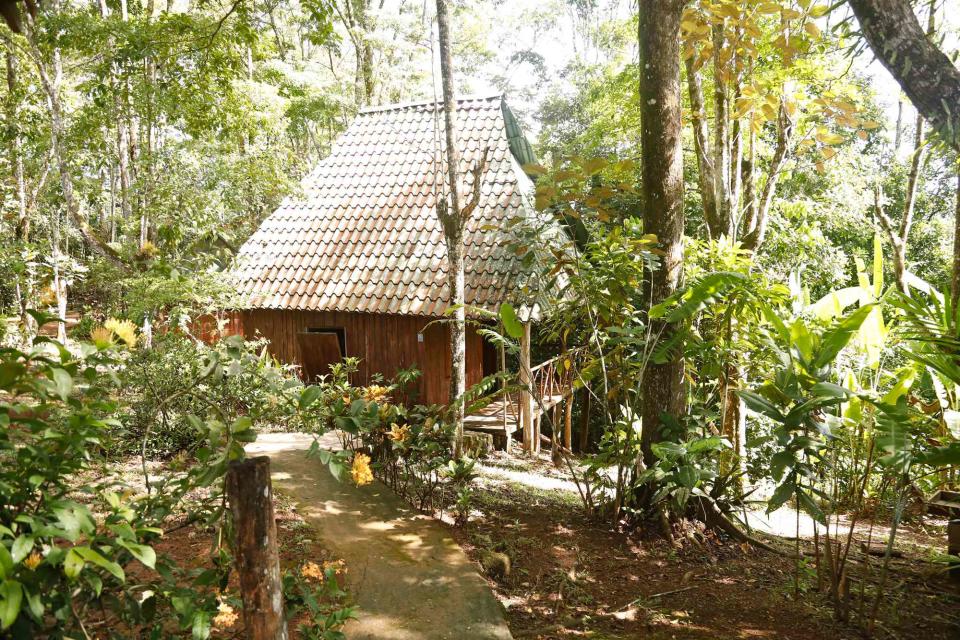
Lebo Lukewarm/Courtesy of Intrepid Travel
A home in the Térraba region.A friend once told me that traveling well means ending up in a stranger’s kitchen, and this one certainly proved his point. The room was open, a three-walled haven cooled by a breeze that sifted through the guava trees outside. It was a warm, sticky evening in the jungle of Térraba, an Indigenous territory in southern Costa Rica. A dinner table with a checkered blue cloth held plates of fire-roasted pork, peach palm, and ice-cold bottles of tamarind juice.
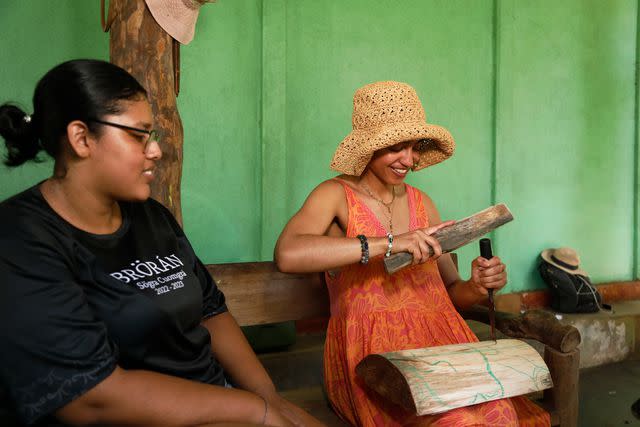
Lebo Lukewarm/Courtesy of Intrepid Travel
Carolyne Rivera, from the Térraba community, teaches a guest to carve masks from balsa wood.Suddenly, a loud ping rang off the roof, startling me. “That’s a nance,” explained our host, Jeffrey Villanueva. “Have you tried it?” His mother, Eulalia, offered a handful of the yellow, almond-size berries, which had been harvested just feet away from her kitchen. When I took a bite, the tangy flavor was electrifying. Sensing my delight, Villanueva showed me star fruit, water apples, and four types of lemons — a tiny sample of the 25 types of fruits and vegetables he grows on the 47-acre farm that has fed his family for centuries. The culinary coup came later, with a warm chocolate drink, made from cacao that he grows on the property and crushes on a 2,000-year-old table-size millstone.
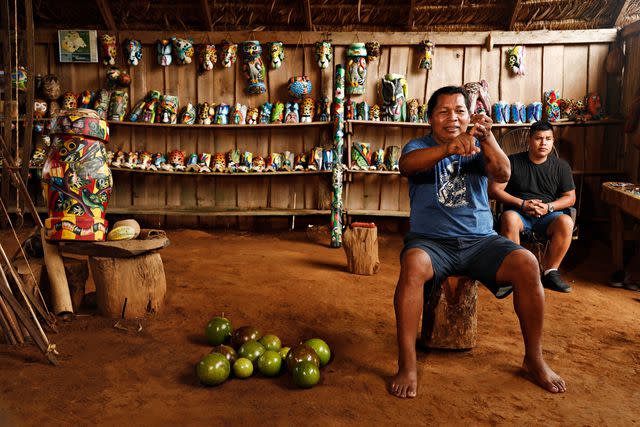
Lebo Lukewarm/Courtesy of Intrepid Travel
Maleku tribal member JaquÃma âEliasâ Elizondo-Castro teaches visitors about local culture.“We are trying to preserve what our ancestors left us,” Villanueva said in Spanish. He is Brörán, a member of a 6,000-person-strong matriarchal community fighting to keep its traditions alive amid local discrimination and land disputes. Foods like these, grown in the soil worked by his forebears, serve as threads to the past. “This is me,” he said. “This is my culture.”
How many travelers dream of going to Costa Rica to surf, raft, and hike among the toucans, sloths, and monkeys? The country’s devotion to conservation is legendary: a power grid crackling with nothing but green energy, wildlife-forward laws, and a new policy prohibiting single-use plastics in its 29 national parks.

Lebo Lukewarm/Courtesy of Intrepid Travel
From left: Helping reforestation efforts with Elizondo-Castro; wooden masks made by Térraba artisans.But it was the bedrock beneath all this that had taken me there. Unlike in Guatemala, Mexico, and Peru — whose Indigenous groups are the topic of entire units in high school history classes — in Costa Rica Native people live largely under the radar. These communities are the country’s original conservationists and keepers of tradition, and to spend time with them is to get a glimpse of the country in a genuine, timeless light.
“It’s a very special heritage that makes me proud,” said Marlen Rojas Montero, who works with my host, Intrepid Travel. “We may not all look Indigenous, but it’s a part of who we are.”
Intrepid leads small-group trips that are considered “responsible”: they uphold standards in everything from staffing support to environmental impact. My custom tour had kicked off a few days earlier in the capital, San José. There, my 14-year-old daughter, Evie, and I had met our guide for the week, Flor de Liz Céspedes, a 36-year-old law student who farms much of her own food. She planned to take us to visit three of the country’s Indigenous tribes: the Brörán, the Boruca, and the Maleku. On the way, we’d visit timeworn ruins, hear stories from Indigenous leaders, and learn some of their crafts.
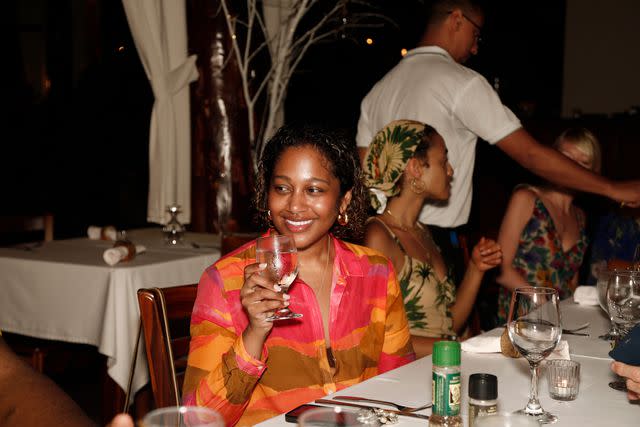
Lebo Lukewarm/Courtesy of Intrepid Travel
Intrepid guests enjoy dinner outside Manuel Antonio National Park.All trips in Costa Rica should start, as ours did, at the Chietón̈ Morén̈ Museum & Market in San José. The name means “fair deal” in the Boruca language, and the shop sells hundreds of ceramics, masks, and textiles made by more than 250 Indigenous artists. In the museum, sobering displays show the shrinking territories and linguistic challenges these communities face. Of the country’s eight remaining Indigenous populations, only four have living languages. Two are reviving theirs, and two more — the Chorotega and the Huetar, which conceived the lingua franca for much of precolonial Costa Rica — are now extinct.
We rolled east out of San José to the magnificent Guayabo National Monument, where we hiked around the ruins of a once-thriving city settled as early as 3,000 years ago. While Céspedes translated, a park naturalist told us about the Cabecar — with 15,000 members, the largest of the Indigenous groups — whose territories include the distant Talamanca Mountain Range. As we walked, a gray-headed chachalaca, a tropical cousin of the chicken, skittered into the forest.
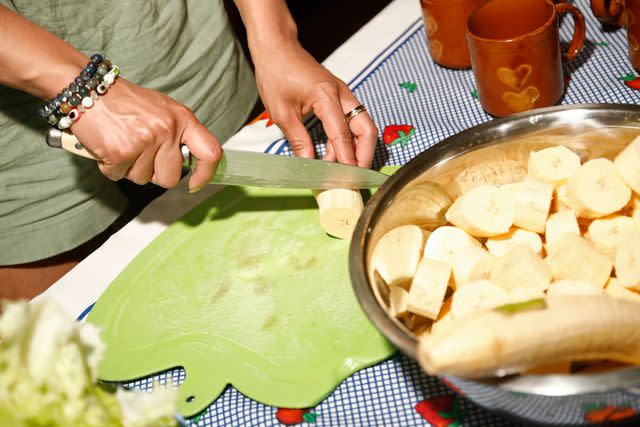
Lebo Lukewarm/Courtesy of Intrepid Travel
Chopping bananas during a homestay cooking class.We returned to our minivan for a five-hour drive south to our last stop of the day: dinner at Eulalia’s home, in the Térraba area. After our delicious meal, Evie and I stayed in Villanueva’s house, located a few steps away, as part of Intrepid’s homestay experience. It was easily my favorite accommodation of the trip: a home, unpolished but spotless, with family pictures on the walls. The room felt hot to my American sensibilities, but as any visitor to Costa Rica can do, I cooled off by drinking water straight from the tap.
The next morning, we rode with Villanueva over bumpy dirt roads to the Boruca community where his daughter lives, catching glimpses of the Térraba River as we went. Villanueva told us stories about an Indigenous deity: “Sbö put my people here to protect this river. To us, this river is a living being.”
We spent much of that day watching artist Sergio González Rojas carve balsa wood into masks in the shape of jaguars and parrots, and sitting with Boruca women as they pounded twiza and suta plants to create gorgeous natural dyes for homespun cotton. “These techniques are so secret my grandmother didn’t even want to teach me,” said Marina Lazaro Morales, her fingers stained with turmeric. Her grandma changed her mind when the Boruca people’s collective knowledge began to wane. “The time has come to share it,” Morales said.
Over the coming days we journeyed west with Céspedes. We hiked around Finca 6, a former plantation and now a museum and archaeological site with ruins and enigmatic stone spheres left by the extinct Diquís tribe. We saw a scarlet macaw in a fig tree by the road and a peevish monkey untroubled by cars near Manuel Antonio National Park. During the last days of the trip, we met members of the Maleku people, painted gourds, and listened to musicians play iguana-skin drums. Today there are fewer than 700 people in the Maleku community, making this group the most vulnerable in the country. “We are all family now,” Jaquíma “Elias” Elizondo-Castro said. “Our way ahead is very difficult.”
Our evening with Villanueva was the most memorable part of our trip. We sat up late talking about schools where the Brörán language is now taught, where kids can learn about the Indigenous cultures and beliefs that have helped shape them. “The tide has shifted,” Villanueva said. “I am hopeful.”
I returned to his house, which no longer seemed so hot. Then I collapsed on the bed and listened to the midnight rain popping on the tin roof, like a message from afar.
Seven-day private trips in Costa Rica with Intrepid Travel from $2,472 per person for groups of one to 12 people.
For more Travel & Leisure news, make sure to sign up for our newsletter!
Read the original article on Travel & Leisure.

